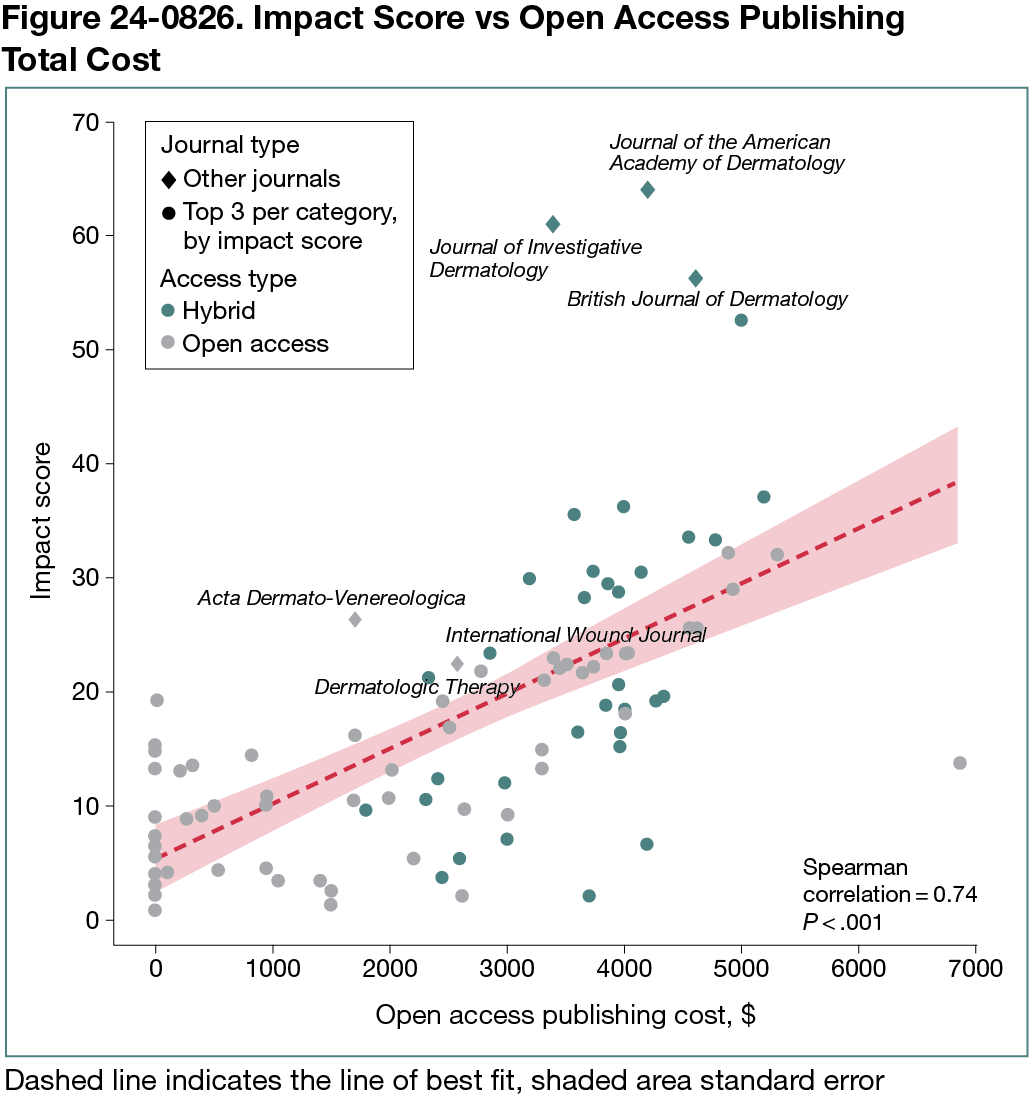Abstract
Assessing the Cost-Effectiveness of Open Access Publishing in Dermatology Journals
Dante Dahabreh,1 Kenny T. L. Ta,2 Angela Rose Loczi-Storm,3 Olivia V. Lim,4 Dana Chen,5 Tasneem M. Y. Issa,6 Alexandria I. Kristensen-Cabrera,6 Rahib K. Islam,7 Robert P. Dellavalle,6,8 Eamonn Maher6,8
Objective
Open access (OA) publishing has revolutionized academic dissemination by providing free research access. However, the financial implications for authors and the impact on journal prestige, particularly in dermatology, are often unclear. This lack of clarity complicates researchers’ publication decisions. This study aimed to evaluate the cost-effectiveness of OA publication models in dermatology journals.
Design
We conducted a cross-sectional study of 144 dermatology journals from the Scimago database between May 13 and June 16, 2024. Of these, 106 journals met inclusion criteria (indexed in PubMed and having an OA option); 38 were excluded for not meeting inclusion criteria, having nonfunctional websites, or missing citation metrics. Journals were categorized as hybrid or full OA. We extracted 2022 metrics (CiteScore, h-index, Scimago journal rank, and 2-year Impact Factor), averaging them for a composite impact score. Article processing charges (APCs) were collected from journal websites. Cost-effectiveness was calculated as impact score divided by total OA publishing cost (cost for free OA journals was set to 1). Statistical analyses, including Wilcoxon rank sum test and Spearman correlation, were performed using R software (R Foundation for Statistical Computing).
Results
Median OA publishing costs were significantly higher for hybrid journals than full OA journals ($3675 vs $350, respectively; P < .05). Hybrid journals also showed significantly higher median impact scores than full OA journals (23.95 vs 9.23; P < .05) (Figure 24-0826). A moderate positive correlation (R = 0.66) was observed between OA publishing costs and impact scores. The Journal of Drugs in Dermatology, Indian Journal of Dermatology, and Dermatology Online Journal were the top 3 cost-effective paid OA options. The Journal of Clinical and Aesthetic Dermatology and the Indian Journal of Dermatology, Venereology, and Leprology were identified as top free OA journals.
Conclusions
Our findings indicate a trade-off in dermatology publishing: hybrid journals, despite higher APCs, generally achieved greater impact scores, suggesting a balance between cost and prestige. While our impact score used established metrics, its broader validation and comparability across other medical subspecialties require further investigation. This study’s cost-effectiveness calculations are based on listed APCs and do not account for fee-assistance programs (offered by 25 of 106 journals) or membership discounts (available for 22 of 106 journals), which can significantly alter the actual cost for individual authors. Future research, incorporating sensitivity analyses on varying APCs (including potential waivers or discounts) and exploring broader measures of influence, is essential to enhance the generalizability and impact of these findings and to better inform authors’ complex OA publication decisions.
1Department of Internal Medicine, Kaiser Permanente, Oakland, CA, US; 2University of Minnesota Medical School, Minneapolis, MN, US, ta000030@umn.edu; 3College of Osteopathic Medicine of the Pacific Northwest, Western University of Health Sciences, Lebanon, OR, US; 4Joan C. Edwards School of Medicine, Marshall University, Huntington, WV, US; 5School of Osteopathic Medicine in Arizona, A.T. Still University, Mesa, AZ, US; 6University of Minnesota Medical School, Minneapolis, MN, US; 7Louisiana State University Health Sciences Center, New Orleans, LA, US; 8Department of Dermatology, University of Minnesota, Minneapolis, MN, US.
Conflict of Interest Disclosures
None reported.
Additional Information
ChatGPT Omega 3 was used on June 18, 2024, to help with statistical analysis and figure generation.

